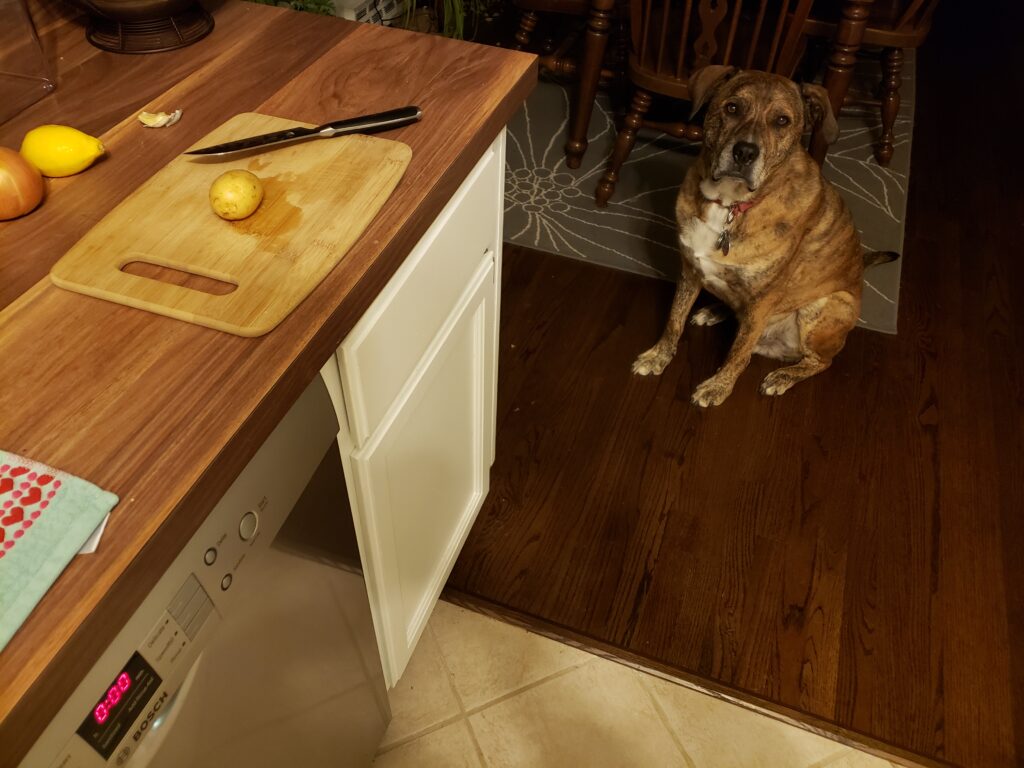I hear the phrase “human food” frequently. For those of you who haven’t heard this term, “human food” refers to foods that we commonly eat as opposed to food that is specifically marketed for our pets’ consumption. Usually it pops up in one of the following phrases:
I never give him human food.
Is it okay to give him human food?
If I use human food for training won’t it make her beg?
I’m going to be blunt. This phrase bothers me, for several reasons, one of which is because it’s pretty arbitrary. What’s the actual difference between “human food” and “pet food”, especially with the higher quality foods now available for our pets? They’re both edible and in many situations they’re the same core ingredient. Whole, natural foods should not be exclusively for human consumption.
Another reason for my gripe is that I think this phrase unnecessarily burdens some aspects of training and behavior modification. Let’s explore a few examples of how this distinction can be burdensome:
I recently met with a new client who had already started her behavior modification journey with a veterinary behaviorist. She mentioned the expense that comes with behavior modification: the veterinary behaviorist, me, and the treats. She was using great-quality, expensive treats for activities requiring high-value food. I commended her for using great treats, and agreed that they were expensive, which is why I use things like boiled chicken, string cheese, and peanut butter for Oso’s high-value foods. He loves them, I have them on hand more frequently, and they’re way cheaper than pet foods that he equally loves. I saw a look of relief cross her face as she admitted that she hadn’t thought about using those kinds of foods.
A few years ago, I had a client who wanted to work on her dog’s behavior while she was making dinner. We discussed the management options but she really wanted to work on training instead, so we started talking about place training. She told me that she wasn’t keen on using treats for this because she’d need to wash her hands too frequently between working with the dog and preparing the meal. I suggested she use dog-safe components of whatever she was cooking, instead of store-bought treats, and that solved that problem. The dog now calmly waits on her mat instead of being a nuisance in the kitchen.
Sometimes we create our own problems by having an arbitrary distinction between “human food” and “pet food”, as seen above. Instead, I tell clients that as long as it’s safe (I.E. non-toxic and does not cause digestive problems) and your pet likes it then consider it an option for training.
But does that make them beg?
Often, when I recommend using meats, cheeses, fruits, and vegetables, I get some form of the question, “But does that make her start begging?” I think this is more the point that people are after when they talk about “human food” vs. “pet food” in the first place. So let’s address that!
There is nothing intrinsic to the food we eat that makes our pets beg. Sure, we eat some things that our pets may find pretty tasty, but that’s probably not true of everything (even Oso decided ginger wasn’t his jam). The same rules of food preferences and high-value foods vs. low-value foods still apply regardless of who the food is marketed for (check out last month’s blog post on food preferences here!) The reason that some people see an increase in begging when giving their pets “human food” is all about the delivery and timing, which is being incorrectly conflated with the food itself. Let me show you a few examples.
Here’s a picture of Oso, who is learning to stay out of the kitchen while we cook. Specifically, I want him to be on the hardwood instead of the tile. He gets to choose where exactly that is and in what position he’s in. I trained this behavior using– you guessed it– the dog-safe ingredients from our meal (particularly veggie scraps we weren’t going to eat anyway).

Here’s another example of Oso while we’re eating. The behavior I want is for him to lie next to me and I trained this using food from my plate.

And one last one: snacking on the couch means “head down”. I also trained this with the food I was eating.

It’s clear the old adage, “Don’t feed your dog from your plate or else he’ll beg”, doesn’t have to be true. So what’s the difference?
The reason that Oso can politely hang out while being trained with “human food” is because I kept in mind that our pets are always learning, even if we don’t mean to be teaching them. I reinforced Oso for very specific behaviors that I liked instead of giving him food willy-nilly or based on my behavior (E.G. When I’m done eating he licks the bowl clean, regardless of what he was doing before I offered the bowl).
Reinforcement increases the probability of a behavior happening again. We do things that work for us, our pets included. Additionally, to truly be reinforcing the consequence has to happen within 3-5 seconds of the behavior and there can’t be another behavior in between (behavior chains are a thing that make the last part of that sentence not completely accurate, but that’s a topic for another day). That means that I need to be strategic about when I give him food in order to get the behaviors I want to see more of.
If I were to give him snacks for classic “begging” behaviors– putting his nose next to my plate, his head on the table (he’s barely tall enough), nudging my hand– then those are the behaviors I’d see more of. Instead, I only gave him snacks when he was on the hardwood (which gives us space), lying down, or with his head down, respectively. So I got more of those behaviors! The trick is in the timing.
Now what?
- Do you have a mental block against using “human food”? Let’s start small. Do a food preference test with some veggies (frozen often work great) to see if you can incorporate any of those into your training.
- Ready to try it out? Try teaching a stationing behavior (go to a place and hang out there) while you’re doing something with food: preparing a meal, eating.
- Working through a behavior modification plan with your consultant? Do a food preference test to determine if there’s something higher-value than what you’ve been using. Meats are a classic go-to for both dogs and cats.
- Share with us your own examples of training with “human food” on Facebook or Instagram @petharmonytraining.
Happy training!
Allie
